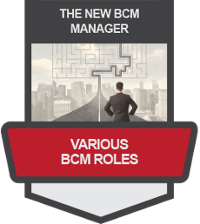Do Not Make Any Changes Before ...
 As a new BCM manager or in BCMPedia, the generic title of Organisation BCM Coordinator, there is pressure to perform and show results.
As a new BCM manager or in BCMPedia, the generic title of Organisation BCM Coordinator, there is pressure to perform and show results.However one of the worst things the new BCM manager can do is to jump into a flurry of activity. The situation is badly disrupted with the COVID-19 outbreak.
It is even worse, to make major changes to the existing structure and plans without regard and careful consideration of:
- the nature of the industry;
- the regulatory framework governing it; and
- the risk appetites of management and other interested parties, as well as the prevailing social and political climate.
Doing so frequently leads to potentially disastrous results. My post on One Mistake to Avoid elaborates further.
Instead, the new BCM manager would do well to conduct a thorough assessment of the organisation's Business Continuity Management System or BCMS before rocking the proverbial boat.
An analysis of the gaps in the management system serves to identify key areas that are weak, or even totally absent, that the new BCM manager can use to build his initial work plan.
Understand the Organisation
A good understanding of the organisation, as discussed in my post Understand the Organisation is critical in addressing the issues mentioned in the preceding paragraph.
If a prior audit had been conducted, the findings could be immensely useful in identifying Standard non-conformities, sometimes referred to as "gaps" and getting management to buy in on subsequent remedial action. ISO 22301 is the de facto international BCMS Standard and is a useful benchmark to measure your organisation's BCMS when doing an audit or gap analysis.
Getting Hold of the ISO Standards to Audit
 Even if this is the first time the organisation is embarking on BCM, the ISO 22301 Standard and its accompanying guidance document, ISO 22313, is helpful in guiding the development of an appropriate framework and policy, and subsequently the implementation of the BCM programme.
Even if this is the first time the organisation is embarking on BCM, the ISO 22301 Standard and its accompanying guidance document, ISO 22313, is helpful in guiding the development of an appropriate framework and policy, and subsequently the implementation of the BCM programme. ![TMM [A-5] ISO22301 BCMS Lead Auditor Tell Me More](https://no-cache.hubspot.com/cta/default/3893111/6ecf12cc-3bff-44e3-8ebb-65fefc587901.png) BCM Institute offers courses for auditors based on ISO 22301 principles. More information on these audit courses can be found here.
BCM Institute offers courses for auditors based on ISO 22301 principles. More information on these audit courses can be found here. Starting Your Gap Analysis
.png?width=300&height=161&name=images%20(1).png)
As you go about the gap analysis, you will have the opportunity to talk with various people within your organisation - their needs for BCM and their general experience of how the current system is working for them.
Pay close attention to what they say and take note of any 'deficiencies' they raise, be they real or perceived. In particular, listen to their use of BCM terminology.
Lack Consistent Understanding of BCM Term
Often one might find the same BCM term used by different people to have different meanings. The Operations Manager may interpret Recovery Time Objective (RTO) in one way, while the IT Manager may interpret the same term in a completely different way.
This confusion in the use of BCM terminology has led to countless arguments, sub-optimal recovery, and unfulfilled expectations.
Compile and Standardise BCM Glossary
 It is good practice for the new BCM manager to compile a glossary of common BCM terminology and attempt to standardise their definitions across the organisation, aligning these definitions with the ISO 22301 standard. An ISO 22301 glossary can be found here.
It is good practice for the new BCM manager to compile a glossary of common BCM terminology and attempt to standardise their definitions across the organisation, aligning these definitions with the ISO 22301 standard. An ISO 22301 glossary can be found here.The New Manager Series
 |
 |
 |
 |
 |
 |
 |
|
| Understand Your Organisation | Build Competency | Common Mistakes to Avoid | Various BCM Roles | Perform a Gap Analysis on Your BCM Program | Improve BCM Competency and Skill |
BCM Job Description
|
Need to Upgrade Your BCM Competency?
More Information About Blended Learning BCM-5000 [BL-B-5]
To know more about our blended learning program and when the next course is scheduled, feel free to contact our friendly course consultant colleagues via sales.ap@bcm-institute.org. They are the BL-B-3 Blended Learning BCM-300 ISO22301 BCMS Implementer and the BL-B-5 Blended Learning BCM-5000 ISO22301 BCMS Expert Implementer.
![FAQ [BL-B-3]](https://no-cache.hubspot.com/cta/default/3893111/b3824ba1-7aa1-4eb6-bef8-94f57121c5ae.png) |
Please feel free to send us a note if you have any of these questions to sales.ap@bcm-institute.org |
 |









